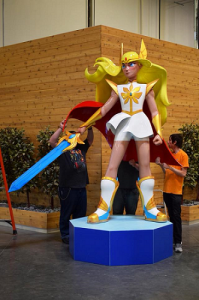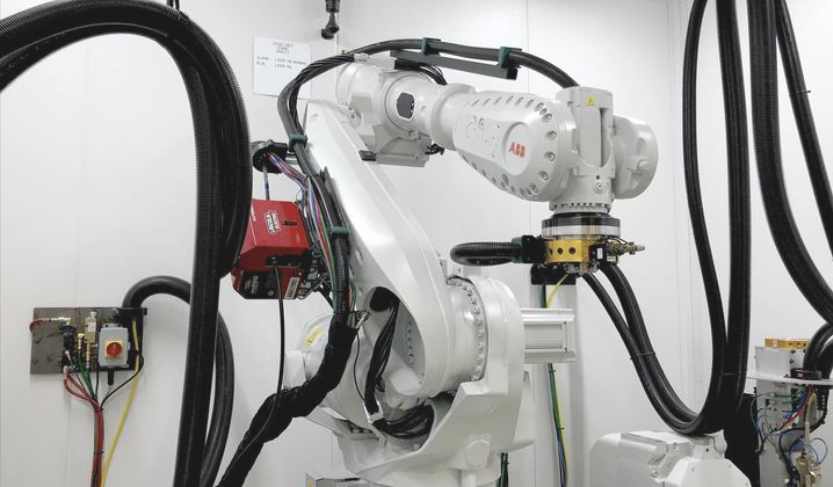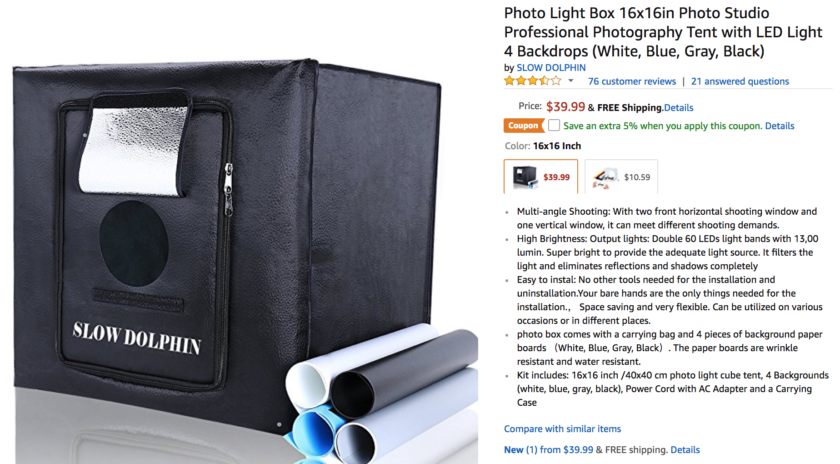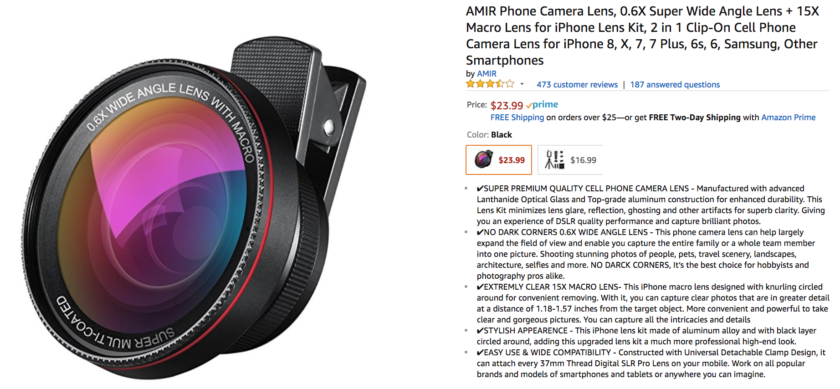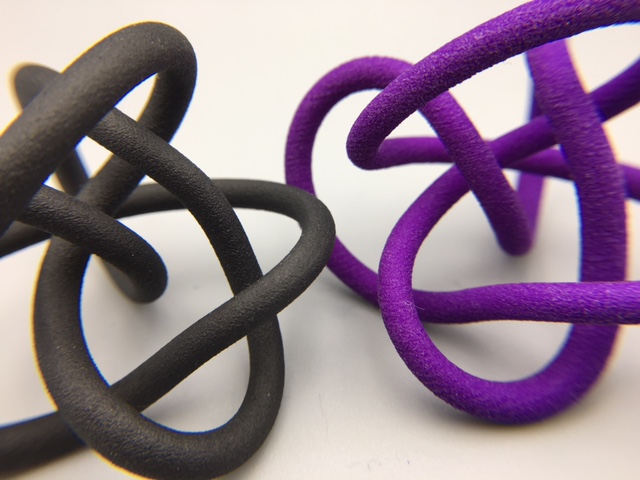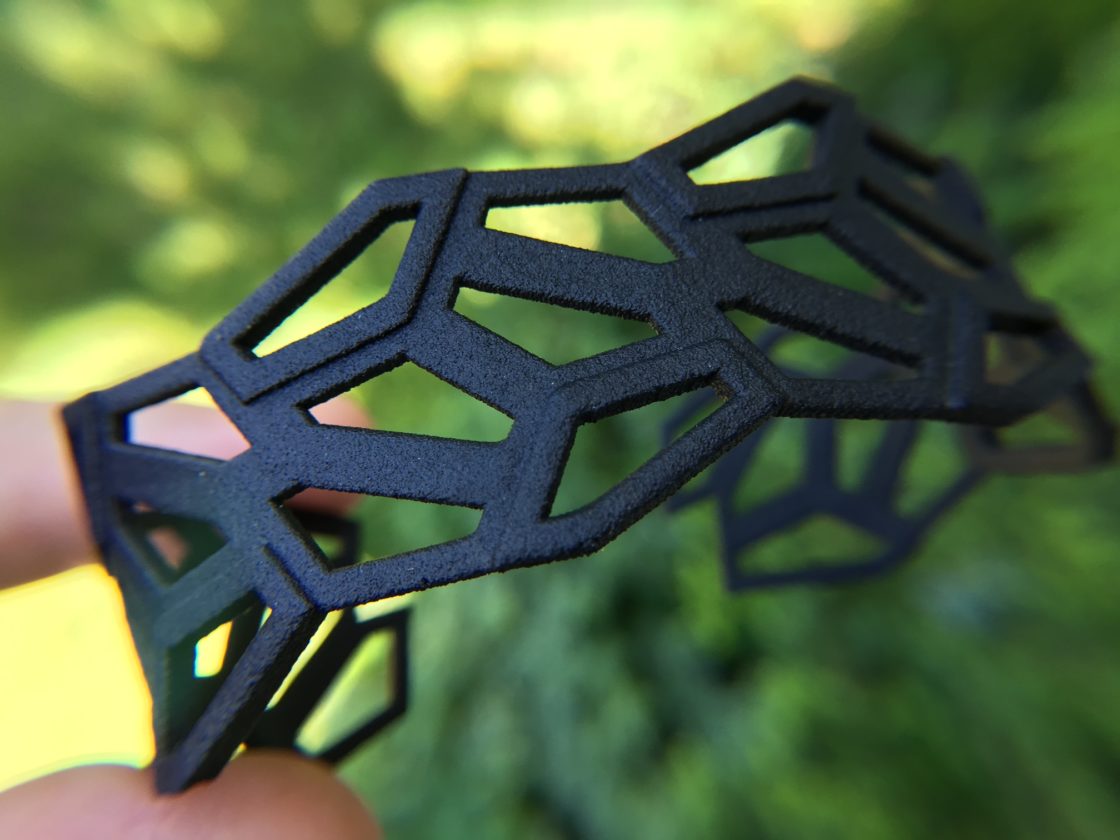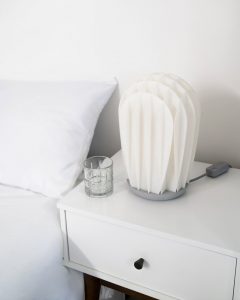Interview With Valuechain on ERP and MRP for Additive Manufacturing
“Valuechain Technologies is a global enterprise software business which provides modular ERP solutions for advanced manufacturing sectors, and supply chain intelligence solutions. Focusing on niche processes such as additive manufacturing, Valuechain’s modular ERP integrates CRM, compliance auditing, data capture, advanced reporting, NPI and supplier portals to digital business processes to improve productivity. Valuechain’s supply chain intelligence applications include supply chain performance management, multi-tier supply chain mapping, and supplier / customer portals. Designed by Valuechain’s leadership team, with over 100 years’ experience owning and running advanced manufacturing companies, Valuechain’s solutions are developed in collaboration with our 500+ SME clients and leading manufacturing companies including Airbus, Bentley Motors and Rolls-Royce, to provide scalable solutions for companies of all sizes.”
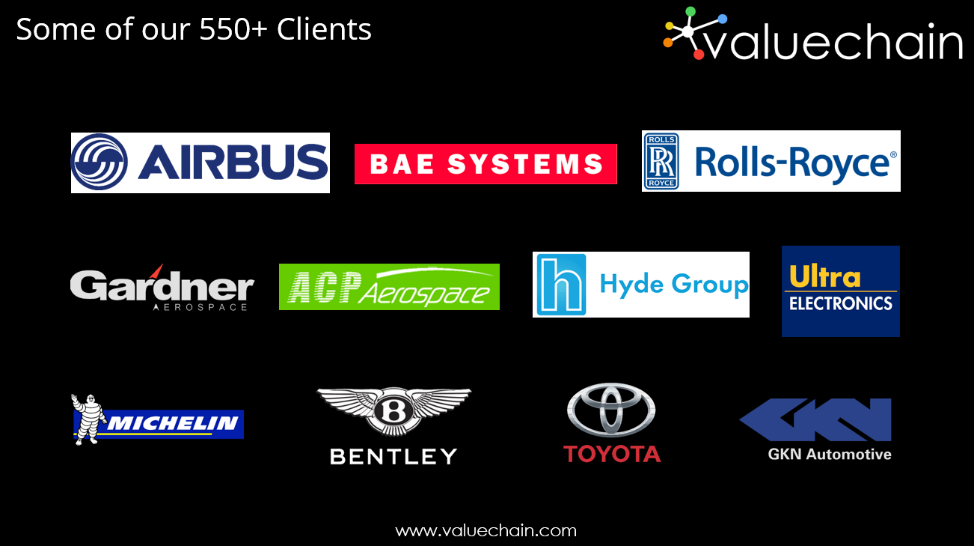
“The ability to visualise products and processes in a virtual environment can reduce waste significantly by accelerating technical problem solving and knowledge transfer through lower risk prototypes and simulated pilots. This compresses new product introduction and enables businesses to engage stakeholders prior to major investments in people, product, plant, processes and systems which not only mitigates risk but also reduces quality non-conformances, costs and drives on-time in full delivery.”
“The priority must be to create capacity for change which for many companies is about streamlining data capture and removing waste caused by fragmented systems and processes. It is important to understand current performance measures and prioritise improvement areas with tangible success criteria. Through digital production control, work flow and business intelligence solutions such as Valuechain’s solutions it is then possible to do more with less and operate smarter by providing key personnel with reliable business intelligence to make informed decisions. Too many businesses focus on historic KPIs ie. what happened, rather than focusing on why things are happening and what is likely to happen, it is therefore critical to capture diagnostic analytics to capture risks and lessons learned to embed corporate learning that can underpin AI driven predictive analytics.”
“We have either a complete end to end MRP solution including our AM TRACE module, which will handle the whole of life production and sub con / post processes operations from estimating through to invoice or alternatively the AM TRACE module is available as a bolt on “app” for existing and legacy MRP ERP or MES solutions. We also currently have two versions of this, AeroDNAam DNAam and new this year is our DNAam Start-Up Program to assist smaller SME companies enter the AM sector.”

“DNAam was designed for AS9100 Aerospace manufacturing initially but since its launch at Paris Air Show in 2017 with the backing of our first clients and innovation partners AIRBUS and Zenith Tecnica in New Zealand. However not surprisingly the unique and dynamic TRACE solution for materials and consumables associated with the manufacturing process has attracted interest from the Medical Automotive and Heavy industries also such as shipbuilding along with Oil & Gas. That will only continue to grow for us.:
“Highly regulated sectors such as aerospace and automotive require end-to-end traceability to ensure accountability for compliance throughout the product lifecycle. Additive manufacturing offers significant opportunities to optimise raw material usage but only if unused powders and materials can be recycled. However scaling up traceability for all recycled and blended AM material batches has prior to DNAam has been complex, manual and prone to human error.”
Visual Stock management tool: DNAam’s visual stock location management Drag and drop Gins between locations as they progress along the production process, from Goods In to Powder Storage, to Machining to Blend area. Any time you move a Gin, a record is automatically recorded of who moved what, when, and to where; so you have complete audit traceability.
- Configurable chemical elements for each material , to store sample results.
- Graded material control.
- Detail production data capture forms (iQapture)
- Visual AM-Trace tool: Two major challenges of implementing AM parts in aviation are traceability of the powder and achieving repeatability in the process to standardise it. The trace tool allows us visualise every build in which a batch of powder has been used by clicking on it. This intuitive tool provides complete traceability which can be used to scale-up AM production, not only in aerospace but in all types of industries.
“DNAam has been innovated in collaboration with some of the world’s leading advanced manufacturing companies such as Airbus, to embed best practice, scalable AM business processes and capture AM business intelligence. As a modular solution DNA.am can work alongside existing ERP solutions for primes and tier 1’s, or as a cost-effective turnkey ERP system from quotation through to invoicing for smaller AM businesses or even start-up AM bureaus.”
3D Printing News Briefs: October 10, 2018
It’s business news as usual to kick things off in today’s 3D Printing News Briefs, and then we’re moving on to a little medical and metal 3D printing news, followed by a 3D printing experiment and a superhero-sized 3D printed statue. The LEHVOSS Group is expanding the production capacities for its LUVOCOM material, DyeMansion has announced that its new RAL colors are now available, and the Million Waves Project receives a large grant from Shell Oil. A medical technology company is using HP’s Multi Jet Fusion to 3D print dental aligners, a YouTube video shows the depowdering process for a metal 3D printed turbine, and an experiment shows if it’s possible to use a DLP 3D printer for PCB etching. Finally, WhiteClouds designed and 3D printed a huge statue of She-Ra for a special event.
LEHVOSS Group Expanding LUVOCOM Production Capacity
 Not long ago, the LEHVOSS Group, which operates under the management of parent company Lehmann&Voss&Co., revealed that that it would be showcasing its high-performance, thermoplastic LUVOCOM 3F 3D printing compounds at upcoming trade shows. Now, in order to keep meeting the ever increasing demand for these materials, the company has taken important steps, such as constructing a new laboratory and innovation center in Hamburg and commissioning an additional compounding line, to expand the worldwide production capacities for LUVOCOM.
Not long ago, the LEHVOSS Group, which operates under the management of parent company Lehmann&Voss&Co., revealed that that it would be showcasing its high-performance, thermoplastic LUVOCOM 3F 3D printing compounds at upcoming trade shows. Now, in order to keep meeting the ever increasing demand for these materials, the company has taken important steps, such as constructing a new laboratory and innovation center in Hamburg and commissioning an additional compounding line, to expand the worldwide production capacities for LUVOCOM.
“At the same time, these investments are just another consistent step within the framework of our long-term growth strategy,” said Dr. Thomas Oehmichen, a shareholder of Lehmann&Voss&Co. with personal liability. “Additional extensive investments in the expansion of our plastics business are currently the subject of detailed planning and are set to follow shortly.”
DyeMansion’s New RAL Colors Available
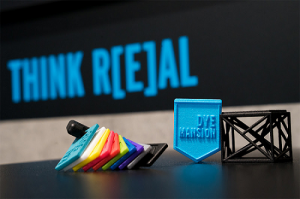 While attending the TCT Show in Birmingham recently, DyeMansion launched three machines that work together to depowder, surface treat, and dye 3D printed parts. The DM60 is the fully automated dyeing part of the system, and the company added a brand new palette of 170 standard RAL colors for PA2200 to its portfolio to let people expand the color range of the system significantly.
While attending the TCT Show in Birmingham recently, DyeMansion launched three machines that work together to depowder, surface treat, and dye 3D printed parts. The DM60 is the fully automated dyeing part of the system, and the company added a brand new palette of 170 standard RAL colors for PA2200 to its portfolio to let people expand the color range of the system significantly.
DyeMansion has now announced that its new RAL colors for the PolyShot Surfacing (PSS) finish are now available for DM60 color cartridges, and can be ordered via the DyeMansion On-Demand Service. To check if your favorite colors are available, type in the RAL color code on the website. To learn more about the RAL palette and the Print-to-Product workflow, visit DyeMansion’s booth 3.1-G61 at formnext in Germany next month.
Shell Oil Gives Million Waves Project a $5,000 Grant
 About 40 million people in the developing world don’t have access to the prosthetic limbs they desperately need, while an estimated 28 billion pounds of plastic trash is dumped into our oceans each year. 501c(3) non-profit organization the Million Waves Project is working to fix both of these problems by using recycled ocean plastic to make inexpensive, 3D printed prosthetic limbs for children. The organization is pleased to announce that it will be now be able to make even more 3D printed prosthetics for kids thanks to a $5,000 grant that Shell Oil is providing.
About 40 million people in the developing world don’t have access to the prosthetic limbs they desperately need, while an estimated 28 billion pounds of plastic trash is dumped into our oceans each year. 501c(3) non-profit organization the Million Waves Project is working to fix both of these problems by using recycled ocean plastic to make inexpensive, 3D printed prosthetic limbs for children. The organization is pleased to announce that it will be now be able to make even more 3D printed prosthetics for kids thanks to a $5,000 grant that Shell Oil is providing.
“We are so excited to partner with this incredible nonprofit that aims to help serve the millions of people in need of prosthetic limbs,” said Brenna Clairr, an external relations advisor at Shell. “Our vision at the refinery is to proudly fuel life in the Pacific Northwest for our employees, contractors and our community, and we help bring that vision to life by collaborating with organizations like a Million Waves Project.”
HP’s MJF Technology Used to 3D Print Dental Aligners
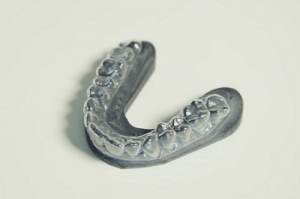 Swiss medical technology company nivellmedical AG is focused on developing, manufacturing, and distributing nivellipso, a novel clear aligner system for correcting misaligned teeth. The system, a more aesthetically pleasing alternative to the conventional fixed braces, uses biocompatible, invisible plastic splints that gently move teeth to the desired position. The company is using HP’s Multi Jet Fusion technology to make its dental aligners, which has helped improve its digital workflow.
Swiss medical technology company nivellmedical AG is focused on developing, manufacturing, and distributing nivellipso, a novel clear aligner system for correcting misaligned teeth. The system, a more aesthetically pleasing alternative to the conventional fixed braces, uses biocompatible, invisible plastic splints that gently move teeth to the desired position. The company is using HP’s Multi Jet Fusion technology to make its dental aligners, which has helped improve its digital workflow.
“We are putting our focus on precision and quality work,” said Dr. Milan Stojanovic, the head of the nivellmedical board. “3D printing technology has simplified a lot of the production of aligners.
The patient’s mouth is scanned, and the scan is then sent to the laboratory, where a model is 3D printed and used to properly fit the aligners before they are shipped out to the patient. Learn more about the process in the video below:
Depowdering a Metal 3D Print Build
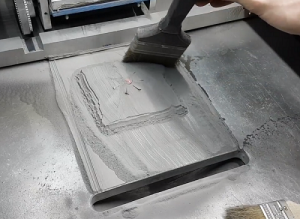 Have you ever seen those videos on the internet that are supposed to be ‘oddly satisfying’ and stress-reliving in a way you can’t quite figure out? The ones that show a ton of matches lighting up in a pattern, or someone slowly squishing their hands in a beautifully decorated pile of slime or some other weird material? Nick Drobchenko, a YouTube user from Saint Petersburg, has now introduced the 3D printing equivalent with his video of using a brush to slowly remove the metal powder from a 3D printed part.
Have you ever seen those videos on the internet that are supposed to be ‘oddly satisfying’ and stress-reliving in a way you can’t quite figure out? The ones that show a ton of matches lighting up in a pattern, or someone slowly squishing their hands in a beautifully decorated pile of slime or some other weird material? Nick Drobchenko, a YouTube user from Saint Petersburg, has now introduced the 3D printing equivalent with his video of using a brush to slowly remove the metal powder from a 3D printed part.
“Hollow stainless steel turbine, 90mm diameter. Printing time 4.5 hours,” Drobchenko wrote in the video description. “Printing cost $140, about 30 cm3.”
If the video below does not soothe and/or satisfy you, then I’m not sure what will:
Can a DLP 3D Printer Be Used for PCB Etching?
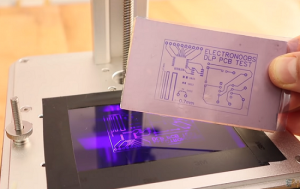 A maker named Andrei who goes by Electronoobs online recently acquired a couple of DLP 3D printers. After reviewing them, he wanted to see if it was possible to use DLP 3D printers to build the mask for PCB etching. So he created an experiment – with surprising results – and published a video about his experience on YouTube.
A maker named Andrei who goes by Electronoobs online recently acquired a couple of DLP 3D printers. After reviewing them, he wanted to see if it was possible to use DLP 3D printers to build the mask for PCB etching. So he created an experiment – with surprising results – and published a video about his experience on YouTube.
“I would only use the UV light of the printer to create the mask for the PCB, and then etch it using acid for copper PCBs just as always,” he explained in the video.
In addition to the DLP 3D printers, other things required for this experiment included copper boards, dry photosensitive film, sodium carbonate, latex gloves, and an iron. Spoiler alert – Electronoobs succeeds in using DLP technology to 3D print a mask for PCB etching. To see the rest of his impressive experiment, check out the video below:
3D Printed She-Ra Statue for New York Comic-Con
Utah-based 3D printing services company Whiteclouds has plenty of experience with the technology in many applications, from aerospace, gaming, and mapping to medical for both animals and humans. But recently, the employees got to participate in a project that was, as Whiteclouds CEO Jerry Ropelato told 3DPrint.com, “one of the coolest (and funnest) 3D prints” they’ve ever worked on. The company was asked to design and 3D print the statue of She-Ra at the recent New York Comic-Con.
“It was our tallest at 11 foot tall,” Ropelato told us.
DreamWorks and Netflix are bringing She-Ra and the Princesses of Power back to life with an animated series that will begin next month. According to a Facebook post by Ropelato, Whiteclouds enjoyed every bit of the Comic-Con project, which included designing and 3D printing She-Ra’s throne and sword. The team used touch-sensitivity electronics for activating the sound and lighting for the statue, and were proud to have a small part in the She-Ra reboot.
Discuss these stories and other 3D printing topics at 3DPrintBoard.com or share your thoughts in the comments below.
Researchers Developing Wireless Self-tracking Objects
We’ve previously covered the efforts of Washington University in creating wireless communicating printed objects. The university created a range of objects that could communicate with other objects without electricity, conveying basic information using antennae. Now, researchers are applying the same principle to in brand new ways to track object usage. These new wireless self-track objects […]
The post Researchers Developing Wireless Self-tracking Objects appeared first on 3D Printing.
Historic Russian fountain restored with concrete 3D Printing
Thermwood and Boeing Make Large 3.6 Meter 3D Printed 777X Program Tooling Part
Thermwood and Boeing have announced that they’ve made a large 3D printed composite part for Boeing’s 777X program. The Thermwood’s LSAM technology was used to make a 20% carbon fiber reinforced ABS part. The part is a “12-foot-long R&D tool.” This demonstrates the possible applications of polymer 3D printing for large parts for aerospace, albeit in experimental tooling.

Boeing’s 777X program will create Boeing’s next-generation long-range wide-body airliners. The 777-8 and 777-9 aircraft will be the mainstays of many point to point long distance fleets of global carriers. The 777-9 will carry over 400 passengers over 13,000 kilometers. Having maxed out composites on its 787 aircraft Boeing is looking to bring its expertise in composite materials to these twin-aisle airliners. With folding wing tips and expected inefficiencies, they will double down on Boeing’s strategy to focus on connecting disparate dots on the earth together with direct flights. This in contrast to the Airbus strategy of efficient short-haul airliners combined with hub and spoke with large A 380’s flying between big cities. Composites were crucial to Boeing’s development of the 787. Boeing was also a very early (think 1995) pioneer in using various 3D printing technologies on many military and civilian platforms. To see these two technologies intertwine in LSAM feels very logical indeed.
Thermwoos’s Large Scale Additive Manufacturing machine and its Vertical Layer Print (VLP) 3D printing technology can make large composite parts. With LSAM a wheel presses down a layer as it is being printed on the previous layer. Print speed depends on the cooling on the polymer itself and the printed part is either printed on a scaffold. The company calls this a “bead board” because the droplets of plastic “beads” are glued to it. LSAM is a very interesting approach that gives us very large but rather rough parts with a good amount of control over layer adhesion.

This particular printed 4 meter part was made in one production run and was intended to save Boeing time. The part also saved on assembly cost. Boeing’s Interiors Responsibility Center (IRC) facility in Everett, Washington now has a Thermwood LSAM machine that it can now use to make parts like this. These kinds of parts could aid in hand layup or assembly operations of existing parts. The high stiffness of the ABS parts should be helpful in that area. One of the amazing things is that with LSAM Thermwood prints ABS at room temperature and through the scaffold and pressing the layer down seems to have little problems with warping. Printing at room temperature would seem to limit the technology somewhat. It would seem to be difficult for the company to use materials such as PEI which are used for end use in aerospace because of the temperatures used. Jason Susnjara of Thermwood told us however that, “We do print other materials such as Ultem, PPS, PSU and PESU.” This is a great step in making large-scale tooling and parts for industry.
A further step where large cabin parts would themselves be made with 3D printing would be even more exciting. For that, a flame retardant material that is certified for civilian airliners will have to be used. A material such as PEEK, PEI or PEKK could perhaps fulfill that purpose but it is unclear at the moment how we would get the heated chamber thermal control to make parts this size out of those materials. Or if LSAM could be adapted to print the right grades of these materials. Simultaneously Boeing would want to instead of carbon fiber which is nasty to make for its employees and is impossible to recycle use a more environmentally friendly material that could be recycled. A hemp PEKK, silk PEI or flax PEEK may sound like a perfectly silly idea but something like them would let Boeing continue to win in 3D printing and composites.
Lockheed Martin Receives Contract to Further Develop 3D Printing for Aerospace Manufacturing
Aerospace company Lockheed Martin, the world’s largest defense contractor, has become a prominent user of 3D printing. Its 3D printed innovations include propulsion tanks and parts for spacecraft and missiles, and recently it completed its largest 3D printed components thus far. Now the company’s work with 3D printing will be expanding, thanks to a new $5.8 million contract with the Office of Naval Research.
 Lockheed Martin and the Office of Naval Research will be investigating the use of artificial intelligence to train robots to independently oversee the 3D printing of complex components. They are customizing multi-axis robots that will deposit material using laser beams. The two organizations are working together to develop software models and sensor modifications to help the robots build better parts, with the goal being for the robots to monitor the process and make adjustments on their own during printing to achieve the correct material properties.
Lockheed Martin and the Office of Naval Research will be investigating the use of artificial intelligence to train robots to independently oversee the 3D printing of complex components. They are customizing multi-axis robots that will deposit material using laser beams. The two organizations are working together to develop software models and sensor modifications to help the robots build better parts, with the goal being for the robots to monitor the process and make adjustments on their own during printing to achieve the correct material properties.
“When you can trust a robotic system to make a quality part, that opens the door to who can build usable parts and where you build them,” said Zach Loftus, a Lockheed Martin fellow for additive manufacturing. “Think about sustainment and how a maintainer can print a replacement part at sea, or a mechanic print a replacement part for a truck deep in the desert. This takes 3-D printing to the next, big step of deployment.”
 The team will vet common types of microstructures used in a 3D print, measure how the 3D printers perform, and align them with the microstructures. They will then gauge the performance of the material properties to develop a working system. The team will be starting with Ti-6AI-4V, the most common titanium alloy, and will integrate related research with seven national lab, university and industry partners.
The team will vet common types of microstructures used in a 3D print, measure how the 3D printers perform, and align them with the microstructures. They will then gauge the performance of the material properties to develop a working system. The team will be starting with Ti-6AI-4V, the most common titanium alloy, and will integrate related research with seven national lab, university and industry partners.
The contract comes after an investment Lockheed Martin made in June in nTopology, which creates additive manufacturing design and optimization software. Lockheed Martin has been involved in 3D printing for a long time, but its activities this year show that the company is serious about continuing to invest in the technology well into the future. This is good news for Lockheed’s many clients, who will benefit from 3D printing technology’s ability to create complex parts in less time and with less cost.
The Office of Naval Research contract isn’t the only one awarded to Lockheed Martin in the past week. The company was also given a $632 million contract to produce Hellfire II missiles for the Netherlands and Japan. The US Army’s Hellfire missile replacement, the joint air-to-ground missile, or JAGM, was cleared for low-rate initial production in June. They will fire from a broad range of platforms including rotary and fixed-wing aircraft as well as ground vehicles, boats and unmanned aircraft.
These missiles will be produced at Lockheed Martin’s facilities in Orlando, Florida, with the work estimated to be completed in 2021.
Discuss this and other 3D printing topics at 3DPrintBoard.com or share your thoughts below.
Tutorial Tuesday: Taking Better Photographs of Your 3D Prints
So you’ve designed something beautiful and the 3D print came out perfectly. But, how do you communicate that online or in your Shapeways shop? In this post, we’ll talk about how to step up your photo-taking game so that everyone knows how awesome your models are.
If you already know something about photography or if you have a nice camera, then this post isn’t for you. Today’s tutorial is for people like me, who needed an easy way to make their phone photos a little bit better and don’t want to break the bank doing it.
Time to Tool Up
For less than $100, you can get two tools that make a huge difference: a lighting tent and a clip-on macro lens.
If you’ve ever tried to find just the right lighting, taking dozens of pictures with different lamps and in different locations inside and outside, then you will love having an LED light box. It can throw diffuse but bright light all around your object. It also allows you to maintain a consistent look at any time of day or night.
There are lots of light boxes out there that seem as if they would work, but the one I’ve fallen in love with is the Slow Dolphin Professional Lighting Tent Box. It comes with seamless colorful backdrops.
If you often find yourself wanting to take closeups of a 3D print but unable to focus properly, or if you want to take pictures that focus on your print but blur out the background, then a macro lens is your solution.
Again, there are lots of clip-on phone camera lenses, available for a wide range of prices. The one I’ve tested and that I used for the example photographs below is the Amir 2 in 1 Professional HD Camera Lens Kit, and specifically, its 15X macro lens:
One Model, Four Photos
Let’s see how these two basic photography tools can help us take better photographs. We’ll use the Rhombicosidodecahedron from our geekhaus shop as the example model. Here is a photo of this model sitting on a black surface in partial sunlight, taken with an iPhone and no other tools:
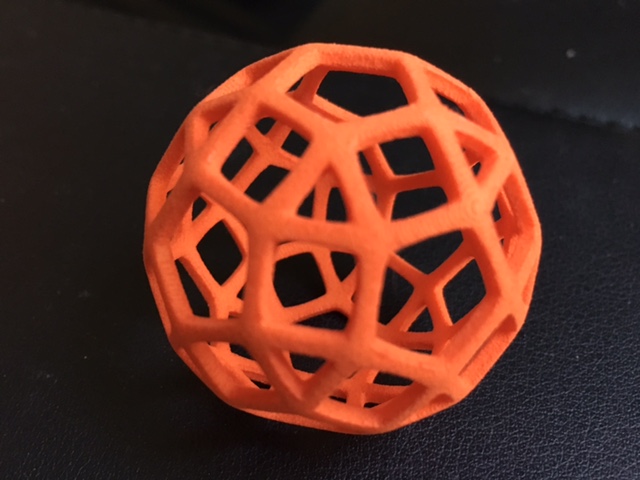
Regular iPhone photo
By clipping on the 15X macro lens, we can focus on the front of the object and have the rear edges blur in the background, which is nice. Notice that we can also capture detail on the surface of the print, and even see some of the layer lines!

iPhone photo with Amir 15X macro lens
To take those two pictures, I had to try a lot of locations in my house before I could find lighting that produced even a reasonably decent photograph, and they still don’t look so great. By putting the rhombicosidodecahedron in the light box, I can get even light all around the object. Here’s a shot with my regular iPhone lens, inside the lighting tent:
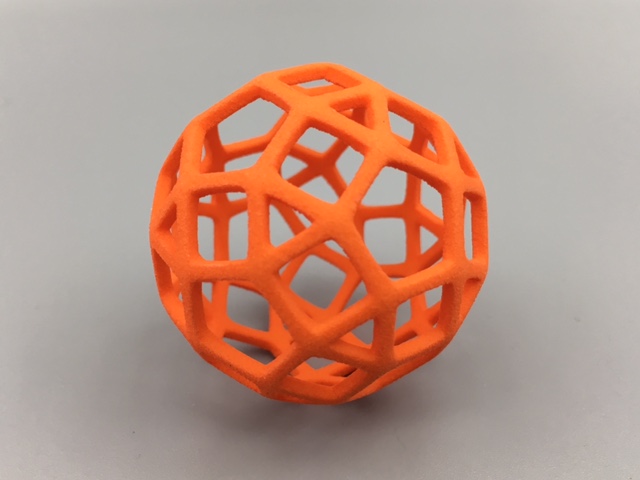
iPhone photo in light box
If we combine both the macro lens and the lighting tent, then we can get a clear, crisp image with focus to the foreground, good surface texture visibility, and no areas with too much light reflecting off the model:

iPhone photo in light box with macro lens
Capturing Detail
Using the macro lens and the light box together, you can capture close-up fine surface detail. Let’s see how it looks with our simple Perko Knot.
The images below compare the surface finish of the Professional Plastic material from Shapeways with Shapeways purple Versatile Plastic on the right. The image has some blurring and distortion toward the edges, but you can see the difference between the smooth black knot and the rougher powdery finish of the purple knot.
Here’s another image, with the more complex Perko Spikes Knot. From this closeup, you can see that the Professional Plastic material smooths out the spikes a bit, but has a pleasant way of making the indented areas lighter than the spikes, which really highlights the texture and path of the knot.
Controlling Focus
You can also use the macro lens in natural environments to take photos that focus tightly on your object while blurring the background. This can be great for product photography, because you can include a pretty background scene without having it distract from your print. For example, here is a picture of our STEIN Pentagonal Tessellation Bracelet taken with no extra lenses, just with a regular iPhone:

Regular iPhone photo
That’s fine, I guess, but the front of the bracelet is slightly out of focus and the background is distracting.
Here’s the same setup with the macro lens:
Much better! This picture does a good job of showing off the soft, slightly rounded edges, the smooth overall finish, and the deep matte color.
What’s in your photography toolbox? Do you have any other recommendations for inexpensive tools to help non-photographers take better photographs of their designs? Let us know in the comments!
Want more design tips and 3D printing news? Sign up to our email list!
Updated: October 9, 2018
The post Tutorial Tuesday: Taking Better Photographs of Your 3D Prints appeared first on Shapeways Magazine.
3D printing news Sliced: United Nations, Mini, Rocket Lab, Sciaky and more
Gantri’s Artistic Lamps Illuminate the Possibilities of 3D Printing

From left to right, the Zeppelin (by L.A.–based Chris Granneberg), the Float (by Milan-based Viviana Degrandi), and the Model TL2 (a Gantri original)
There’s nothing like a good lamp to really tie a room together, and 3D printing has opened up the floodgates for the creation of some very cool lamps. Ian Yang, founder of Gantri, loves 3D printed lamps – so much so that he started a company dedicated to them. Gantri is officially a housewares company, but lighting and lamps are a focal point, and they’re all 3D printed by designers from around the world. The company launched last year with a collection of 30 3D printed lamps, all for less than $200.
The hard part is deciding which lamp you want to accent your home – they’re all fascinating to look at. There’s Iceberg by Hannah Fink, which looks, you guessed it, just like an iceberg. Or you can go with Arco by Arielle Pollock, which resembles a large crystal stood on its end. If you want a more traditional look, there’s the elegant Paris by Javier Martinez, or if lanterns are your thing, you might like 7th Order by HEWN. No matter your taste, you’re likely to find something that suits you and your decor – and you’re supporting independent designers.
3D printing, as Gantri illustrates, allows for some pretty intricate, neat designs, and it also helps designers get their designs off the ground much more quickly. Traditional manufacturing processes usually require 18 to 24 months to launch a new product, but Gantri, using 3D printing, can have a product ready in about 12 to 14 weeks.
Yang studied at the London School of Economics before moving to San Francisco and joining an open-access studio where he began learning about 3D printing, laser cutting, and other advanced manufacturing techniques. He was especially taken with 3D printing, and within two years he had launched Gantri, which is dedicated to using the technology to create unique and affordable functional art.
While 3D printing opens up new possibilities for lighting design, and makes it quicker and cheaper than traditional production techniques, it’s still quite a challenge. When asked why he decided to start with lighting, Yang replied:
“Because it’s so hard to do! It’s a perfect example of the problem we’re trying to solve.”
Gantri’s designers hail from all over the world; there are artists from North America, Brazil, Colombia, the United Kingdom, Spain, Italy and the Ukraine. Each brings a distinctive vision to the table; you won’t find anything like most of these lamps at IKEA. All of Gantri’s lamps are 3D printed from sustainable PLA and are available in shades of white, gray and black. There’s something surreal and futuristic-looking about many of them, which perfectly illustrates the futuristic technology from which they were made. Put a Gantri lamp in your home, and you definitely will have a conversation-starter.
Currently, the design submission process is invite-only, but Yang wants to open it up in the future.
“We attract designers who really want to build their design brands,” he said. “One day we want to support everybody.”
Discuss this and other 3D printing topics at 3DPrintBoard.com or share your thoughts below.
[Source: Architectural Digest/Images: Gantri]

